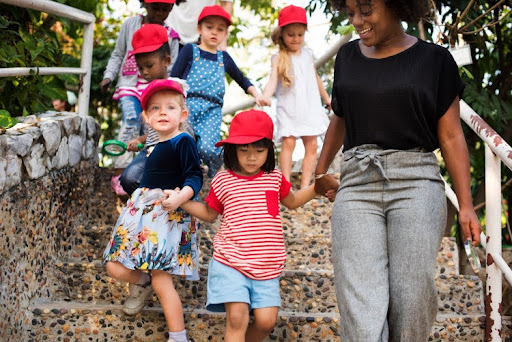Spurred in part by the COVID-19 pandemic and an increasing awareness of the benefits of learning outside, outdoor education is on the rise. For example, the number of nature-based preschools in the U.S. increased from 585 in 2020 to 800 in 2022 (a 37 percent increase), according to the North American Association for Environmental Education (NAAEE).
Preschoolers aren’t the only students who can benefit from outdoor learning. Any student who has the opportunity to learn outdoors can gain from the experience. Therefore, it’s important for teachers to learn about outside instruction and how to help ensure outdoor education safety.
Anyone who has an interest in education or who may be contemplating enrolling in a Master of Education (MEd) in Instruction degree program would be wise to become familiar with outdoor learning and tips for keeping an outdoor instructional environment safe.
What Are the Benefits of Outdoor Education?
Outdoor education opens the door to several potential benefits, as the examples discussed below illustrate.
Increasing Awareness of Nature and the Outdoors
Outdoor learning can strengthen students’ connection with the natural world and motivate them to spend more time in nature. This can build a young student’s interest in the environment, and that connection to the environment can continue through to adulthood.
Expanding Student Perspectives
Students who learn outdoors can be exposed to new ways of viewing the world. For example, learning in nature can encourage a sense of exploration; it can also motivate students to pursue discoveries in subjects that are new to them.
Incorporating New Pedagogical Methods
Teachers have the opportunity to introduce experimental and investigative learning to students when instructing them in an outdoor environment. In a natural setting, students also have the chance to build on what they learn to make strong connections between academic concepts and real-world situations.
Promoting Mental and Physical Health
Outdoor education can encourage students to become more physically active, which can boost both mental and physical health. Exposure to outdoor environments expands their experiences, allows them to take risks and gives them the chance to learn new skills. These experiences can be valuable in both mental and physical development.
Creating Opportunities for Science-Based Observations
The hands-on learning that outdoor education offers can be invaluable. Conducting scientific observations through sight, touch and hearing, for example, can make learning more relevant and improve how well students retain what they learn.
Improving Environmental Literacy
Learning outside builds students’ knowledge and skills directly related to the environment. Students not only acquire expertise about the natural world but also learn about solutions to environmental issues and ways of addressing environmental challenges in the communities where they live.
6 Outdoor Education Safety Tips for Teachers
An outdoor learning environment poses unique challenges to teachers in maintaining outdoor education safety. Following tips such as those outlined below can help teachers ensure that their students can learn in a secure setting.
1. Plan Ahead for Teaching Outdoors
Before moving education outdoors, teachers can plan for how outdoor instruction will take place. For example, they can do the following:
- Identify outdoor hazards that can be a risk to students — such as surfaces that are too hot or rocky areas where it would be difficult for students to walk — and make a plan for addressing them.
- Clearly identify guidelines that specify students’ responsibilities when they’re outdoors, such as sticking with a buddy.
- Set boundaries with students, such as limits on where students are permitted to go within the outdoor environment.
- Develop lesson plans that incorporate the safe use of outdoor elements, such as using safe natural objects to provide instruction on counting.
2. Prepare for Natural Elements
Ensuring that students will be comfortable outside is important, so preparing for exposure to the natural elements will help to strengthen the safety of outdoor instruction. These efforts can also help students focus on learning, rather than on their physical comfort. For example, teachers can do the following:
- Assess risks each day to ensure that they consider new issues that may have developed, such as icy sidewalks or an impending storm.
- Ensure that students’ clothing is appropriate for the weather.
- Select favorable locations for instruction, such as settings that provide protection from the sun.
3. Ensure a Balanced Ratio of Staff to Children
Staff-student ratios are always important in educating children, but they’re particularly critical in outdoor settings that can introduce new risks. Ensuring that enough staff members can be present in an outdoor learning environment to properly supervise children at all times is crucial.
4. Determine Special Requirements
Teachers need to know whether their students have special requirements for being outdoors. For example, having an awareness of how students manage their allergies or other health matters related to being outdoors can help teachers establish safe outdoor educational environments.
5. Establish and Adhere to Routines
Teachers can strengthen safety in an outdoor classroom by developing and sticking to routines that can enhance classroom management. For example, consistently starting outdoor instruction with a discussion of the activities for the day and ending outdoor instruction with a discussion of what students have learned can lend order and organization to outdoor instruction.
6. Actively Supervise Students
Active supervision on the part of teachers and other staff members involved in outdoor instruction is key to instilling safety in outdoor instruction. While having an appropriate number of teachers and staff members to supervise students is important, ensuring that those individuals consistently supervise the students for whom they’re responsible is also critical. For example, it can be helpful for teachers and staff members to physically move around the environment, ensuring that students remain in their line of sight. Teachers and staff members also need to be aware of objects, such as trees or equipment, that can obscure their view of students.
Learning Outside in a Safe Environment Can Be an Enriching Experience for Students
Whether educators are new to teaching or pursuing more advanced MEd careers, ensuring safety in outdoor education is an important consideration. Following the tips for securing the outdoor learning environment can go a long way toward creating an effective setting for learning in which students have the chance to thrive.
Individuals who have an interest in education and instruction can explore Augusta University Online’s MEd in Instruction degree program to learn how it can help them achieve their goals. Providing students with the expertise to create more inclusive learning environments and the opportunity to specialize in areas such as secondary education or special education, the program can establish the foundation for a rewarding career. Start the journey on a fulfilling career path today.
Recommended Readings
5 Tips for Creating an Inclusive Learning Environment
What Is Pedagogy in Education?
Why Is Classroom Management Important?
Sources:
Chesapeake Bay Foundation, “The Quest for Environmental Literacy”
Field Studies Council, “Why Outdoor Education Is an Essential Part of Every Childhood”
Green Schoolyards America, Outdoor Classroom Culture and Management
Green Schoolyards America, Taking Curriculum Outside
North American Association for Environmental Education, Nature Preschools in the United States: 2022 National Survey
Population Education, “Can Nature Be a Classroom? Ten Tips and Tricks to Teaching in Nature”
Twinkl, “A Helpful Guide to Creating Enriching and Safe Indoor and Outdoor Learning Environments”
U.S. Centers for Disease Control and Prevention, Outdoor Play and Safety for Children in ECE
 Augusta University
Augusta University




